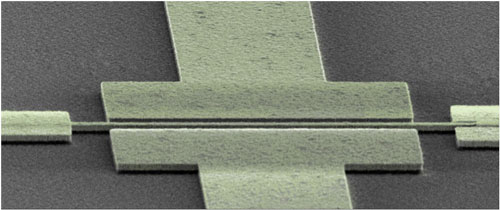| Posted: Dec 08, 2015 | |
Record-breaking performance by three-terminal nanoelectromechanical switch with amorphous metal |
|
| (Nanowerk Spotlight) Current leakage in transistors when they are in the 'OFF'-state is one of the causes of battery depletion in portable electronic devices. This leakage of CMOS circuits increases dramatically with the technology scaling down and has become a critical issue for high-performance systems in nanoelectronics. Developing devices with zero power consumption in the idle/off state has therefore become a top priority. | |
| One solution for this problem could be nanoelectromechanical switches (NEMS). They are inherently mechanical cantilevers, which can move vertically or laterally to make physical contact with the drain electrodes to turn the device 'on'. This all happens under the influence (bias) of the gate electrodes. | |
| An important feature of these devices is that, since they are physically isolated during their 'off' state, they don't leak (i.e. consume) power. | |
| In the past, the U.S. Department of Defense had several multi-million dollar programs focused on developing a NEMS based computer. Key players involved Stanford University, University of California – Berkeley and private sector companies. These programs made significant advances from the perspective of architecture, physics, materials and processing. | |
| However, it was also revealed that even with sophisticated device architectures and material implementation, attaining sub-1 volt operation at dynamic state and faster switching was extremely difficult. These efforts required the use of very expensive lithography systems to pattern nanoscale free-hanging switches. | |
| Now a team from King Abdullah University of Science and Technology (KAUST) in Saudi Arabia, led by Associate Professor Muhammad Mustafa Hussain with his PhD students Abdulilah Mayet and Aftab Hussain, has successfully used the amorphous metal tungsten nitride to demonstrate NEMS that are capable of sub-1 volt operation. | |
| The researchers reported their findings in the December 4, 2015 online edition of Nanotechnology ("Three-terminal nanoelectromechanical switch based on tungsten nitride – an amorphous metallic material"). | |
 |
|
| A 3-terminal nanoelectromechanical switch fabricated with amorphous metal at the KAUST Advanced Nanofabrication Facility (KANF). (Image: Scanning electron microscopic image was captured by KAUST Electrical Engineering Program’s PhD Candidate Student Abdulilah Mayet at the KAUST Imaging and Characterization Lab) | |
| Generally speaking, metals are poly-crystalline and they are hard. Their nanoscale patterning often yields rough surfaces, which eventually result in non-uniform dimensionality, which in turn negatively impacts the switch performance. | |
| "In the past, Texas Instruments (TI) ran a billion dollar product venture on Digital Micromirror Devices (DMD™), an optical semiconductor technology," Hussain tells Nanowerk. "TI developed and used a complex amorphous metal alloy to achieve their success in this microelectromechanical systems (MEMS) product. We have now succeeded in developing a much simpler, low-cost amorphous metal, which not only is integration friendly but its material property can also be tailored to make it suitable for high volume manufacturing." | |
| Using amorphous metal for their NEMS to maintain structural integrity and to enhance performance, Hussain and his team demonstrated a 3-terminal nanoelectromechanical low-voltage switch which – at 0.8 V pull-in voltage – is the lowest ever reported for a NEMS. | |
| "Additionally, this is the first ever demonstration of a 3-terminal NEMS," Hussain points out. | |
| Going forward, the KAUST team will be investigating the implementation of parallel data processing – one input resulting into simultaneous multiple switching actions – and hybrid integration with CMOS circuitry. | |
 By
Michael
Berger
– Michael is author of three books by the Royal Society of Chemistry:
Nano-Society: Pushing the Boundaries of Technology,
Nanotechnology: The Future is Tiny, and
Nanoengineering: The Skills and Tools Making Technology Invisible
Copyright ©
Nanowerk LLC
By
Michael
Berger
– Michael is author of three books by the Royal Society of Chemistry:
Nano-Society: Pushing the Boundaries of Technology,
Nanotechnology: The Future is Tiny, and
Nanoengineering: The Skills and Tools Making Technology Invisible
Copyright ©
Nanowerk LLC
|
|
|
Become a Spotlight guest author! Join our large and growing group of guest contributors. Have you just published a scientific paper or have other exciting developments to share with the nanotechnology community? Here is how to publish on nanowerk.com. |
|
